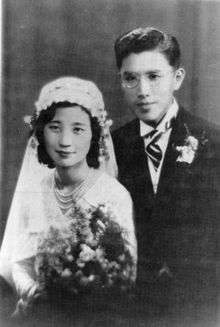Zhou Peiyuan
| Zhou Peiyuan 周培源 | |
|---|---|
 Zhou Peiyuan with his wife in 1932 | |
| Born |
August 28, 1902 Yixing, Jiangsu Province, Qing China |
| Died |
November 24, 1993 (aged 91) Beijing, China |
| Alma mater |
California Institute of Technology(Ph.D.) University of Chicago Tsinghua University |
| Spouse(s) | Wang Dicheng (王蒂澂) |
| Scientific career | |
| Fields | Physics |
| Institutions |
Peking University Swiss Federal Institute of Technology Zurich University of Leipzig Institute for Advanced Study |

Zhou Peiyuan (Chinese: 周培源; August 28, 1902 – November 24, 1993) was a renowned theoretical physicist of China. He was a president of Peking University, and an academician of Chinese Academy of Sciences (CAS).[1]
Born in Yixing, Jiangsu Province, Zhou graduated from Tsinghua University in 1924. Then he went to the United States and obtained a bachelor's degree from University of Chicago in Spring of 1926, and a master's degree at the end of the same year. In 1928, he obtained his doctorate degree from California Institute of Technology under Eric Temple Bell with thesis The Gravitational Field of a Body with Rotational Symmetry in Einstein's Theory of Gravitation.[2] In 1936, he studied general relativity under Albert Einstein in the Institute for Advanced Study at Princeton.[1] He did his post-doc researches in quantum mechanics at University of Leipzig in Germany and Swiss Federal Institute of Technology Zurich. He was a professor of physics at Peking University, and later served as the president of the University. He was elected as a founding member of CAS in 1955.
Tsinghua University's Zhou Pei-Yuan Center for Applied Mathematics is named in his honor.[3] In 2003, a bronze statue of Zhou was unveiled on the campus of Peking University.
References
- 1 2 "Zhou Peiyuan Is Dead – Educator-Scientist, 91". NY Times. 25 November 1993.
- ↑ P'ei Yuan Chou at the Mathematics Genealogy Project
- ↑ Pei-Yuan Center for Applied Mathematics, Tsinghua University Archived September 25, 2015, at the Wayback Machine.